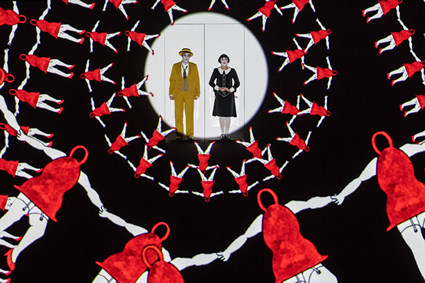| Opera Reviews | 24 April 2024 |
Mostly animationby Michael Sinclair |
|
| Mozart: The Magic Flute
Komische Oper Berlin Auckland Arts Festival 8 March 2019 |
|

Joan Martin-Royo (Papageno), Kim-Lillian Strebel (Pamina)
|
|
|
This Komische Oper Berlin / 1927 production of The Magic Flute should probably have an entry in The Guinness Book of Records for the most widely performed opera production of all time. Having premiered in Berlin in 2012 the production has since been seen by over 450,000 people across three continents, including recent performances in Australia at the Perth and Adelaide Festivals and now here in New Zealand at the 2019 Auckland Arts Festival. Directors Barrie Kosky (Komische Oper) and Suzanne Andrade (1927) in conjunction with animator Paul Barritt have created a spellbinding take on Mozart’s final opera that integrates live singers into a surreal world of animation. The production pays more than a passing nod to the silent film era (though here the singers really do sing) with the clever use of on-screen captions evocative of the genre to replace Schikaneder’s somewhat long-winded dialogue. German Expressionism meets the exuberance of the 1920s, while Sarastro and his priests exude Victorian morals through Esther Bialas’ costumes, and other anachronisms keep us chuckling throughout. And all of this against a backdrop of painstakingly detailed and wildly imaginative animation that includes everything from pink flying elephants, a snarling serpent, musical love bombs to a cat accompanying Papageno that nearly steals the show. The result is eye-poppingly appealing and a tour-de-force in every respect. But there are problems with this concept. The whole production is rather two-dimensional in feel, making this seem like a night at the movies rather than a night at the theatre. The singers are so well integrated into the animation (a compliment to the animators and designers) that it is often difficult to differentiate real from fantasy and the handling and placement of the singers leaves little room for either engagement with each other or with the audience. Do we really care about Tamino’s trials, Pamina’s plight or Papageno’s loveless life? If much of the human element is lost, it is nevertheless made up for through feelings and emotions created through animation. On the musical side this was a solid though hardly remarkable Flute. The Auckland Philharmonia Orchestra took a little time to warm up and while conductor Jordan de Souza kept things moving, the overall reading lacked the clarity and sparkle needed to bring Mozart’s score to life. The production has been double cast from ensemble members of the Komische Oper and their knowledge of this complicated production was evident throughout the evening. On the opening night Kim-Lillian Strebel was a honey-toned Pamina; Aaron Blake an appealing Tamino (though the production doesn’t help his character); Christina Poulitsi an accurate though slightly undernourished Queen of the Night; and Joan Martin-Royo a likeable Buster Keaton-like Papageno. Ivan Turšić stood out as a dark and creepy Monostatos, one of the few singers who was able to project his character across the footlights. The three members of the Tölzer Knabenchor were charming and melodious as the Three Boys – an unexpected delight. Mozart’s opera (written as a Singspiel) was intended to have wide appeal and there is little doubt that this unique production achieves that objective. You may not want to see every opera performed this way, but you probably do want to see this production of The Magic Flute if it comes your way.
|
|
| Text ©
Michael Sinclair Photo © Michael Smith |
|







